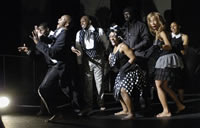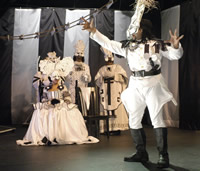
Close Encounters:
My Blacks Story
By Una Chaudhuri
The Blacks
By Jean Genet
East 13th Street Theatre
136 East 13th Street (at Third Avenue)
Mar. 11th - Apr. 6th, 2003
Ticktets: (212) 206-1515
On the night I saw The Blacks, fifteen minutes into
the performance two spectators grabbed up their coats and purses
and rushed out of the theatre. Okay: they were white. Okay:
they were women. Ten minutes later, two others (Okay,
okay: whites, women) got up and began to move towards the
exit. This time a couple of the cast members confronted them,
asked them if they were leaving. “Yes,” they said,
loudly enough that all the rest of us could hear: “This
is very upsetting to us.” They rushed out. We heard later
that one of them was sobbing as she ran through the lobby and
out into the night.
“Upsetting” would be one way to put it. Another way
would be to note that this production of Jean Genet’s great
play by The Classical Theatre of Harlem forces its audience to
think in terms of race and color. Or rather, it forces them to
recognize how much those categories remain a factor in social
perceptions, no matter how much everyone might hope otherwise.
It insists we drop the comfortable pretence of color-blindness
that characterizes middle-class life in America today, and admit
that we do notice color (and gender), all the time,
and that this “noticing” has vastly different implications
for and impacts on different groups.
But the real accomplishment of this production is not in whatever
salutary political insights it may foster. Rather it is in the
way it reenlists the theatre—I mean, the entire theatrical
“apparatus,” as Brecht called it—in cultural
politics. It deploys the elements of performance—gestures,
stillness, sounds, silence, gazes, distance, proximities—in
such a way as to make of the theatre a vivid habitation, a place
in which you can’t help knowing and being yourself. That’s
more than upsetting. It’s terrifying. At first you want
to run out. Maybe you do run out. But if you stay, you experience
something unusually specific. Talk to anyone who’s seen
the play and they’ll start telling you stories about specific
things that happened on the night they saw it. One friend told
me how an audience member (Okay, white) had tried to
flummox an aggressive performer (Okay, black) during
the pre-show by speaking to her in Spanish. The actor replied
in Spanish, didn’t miss a beat. Another friend (Okay,
white) told me how an actor took her cell-phone off her,
star-six-nined her last caller and berated him at length, to the
astonished delight of the audience.
The “site-specificity” achieved by this production
makes the theatre a social laboratory, a place of discovery, perhaps
even revelation. It forces you to notice the myriad details of
behavior and appearance of those in the space with you: Who are
they? How are they reacting to all this? What have they lived
through in their lives that these actors are now reminding them
of? How will they—the spectators, the actors—end up
feeling about race at the end of this play? How will this little
boy (Okay, black) sitting next to me be affected by this
as he grows up, how will it shape his view of whites? Will the
fact that he is so affectionately greeted by the cast offset his
exposure to such a heightened, almost mythic enactment of racial
conflict? How do I feel about being regarded simply as “non-white?”
(“Are you white?” an actor asks me during the pre-show.
When I say no, she moves on to my friends (Okay, they’re
white) and gives them white roses while performing a grotesque
parody of subservience. How do I feel about not being included
in the multi-culti version of Blackness that a part of the audience
gets to perform toward the end of the play? (Okay, I know
how I feel: like I did during the O.J. thing, when every poll
reported the opinions of blacks and whites, leaving the rest of
us feeling liked chopped liver). The inner monologue that
begins during the show goes on long after I leave the theatre.
It is the first and fundamental triumph of this production to
liberate the play from the political abstraction in which Genet’s
ritualistic theatricality and extravagant poetry have tended to
encase it. Genet’s daring meditation on the poetics of racial
hatred is transformed, here, into a courageous encounter with
the social nuts and bolts of the machine of racism, which runs
as efficiently today as it did half a century ago when Genet wrote
the play for an amateur company of black actors. Dispiriting—even
maddening—as such persistence is, there is a measure of
progress in discovering, as this production does, that we are
now ready for a theatrical mimesis that might work to inoculate
us against the Manichean logic of “black or white,”
“us and them” that fuels that machine. Confronting
that logic by rigorously embodying it, not only within the play
but also within the theatre, The Blacks promises a disruption
of its power.
Just such a disruption always lay beneath Genet’s art of
transfiguring transgressions and sacred profanities. But this
production takes Genet’s paradoxes and locates them not
only, as he did, on a richly rhetorical and ritualistic stage,
but also within a firmly situated and painfully localized space,
the specific place and time of the performance. While fully realizing
the baroque spectacle implied in Genet’s text, this production
makes that spectacle secondary to its interaction with the audience.
Thus Ann Lommel’s gorgeous circus set and Kimberly Glennon’s
stunning costumes, both in an uncompromising palette of black
and white, are deeply expressive without in any way reducing—by
aestheticizing—the tension and, at times, even anguish,
of the moment-to-moment encounter between the cast and the spectators.

The Blacks makes the most effective use of environmental
staging that I have seen in a long time, reinvigorating and re-politicizing
it after years of trivialization (think The Donkey Show).
Abandoning the proscenium staging implied in Genet’s text,
it creates an immersive environment of the kind that Artaud had
envisioned, with actors moving about on ramps that run between
and around the spectators, who are seated on swivel chairs. The
change has enormous implications for the political meaning and
effect of the play. The staging envisioned in Genet’s text
placed the two distinct groups in the action—the “white”
court and the black performers—on two levels of a single
stage, framed together within the spectator’s visual field.
Located in this way, the two groups constituted a constant structural
reminder of the intractable racial opposition and mystified social
hierarchy that is the play’s subject. The authoritative
irony of that static staging positioned the audience as passive
voyeurs of the spectacles of racism and colonialism. That passivity
is vigorously contested in this production by a constantly shifting
dynamic that results from the complex spatial arrangement of the
set. That dynamic inscribes itself on the spectators’ bodies—craning
our necks, swiveling our chairs, moving to let actors pass among
us—as much as it does on their emotions and imaginations.
Terrifying (or “upsetting”) as this encounter is,
its literalness and physicality make it also deeply rewarding.
The real credit for that unexpected outcome, rests, of course,
not with the physical staging but with the hugely talented cast,
who are as successful in unleashing the power of Genet’s
poetry as they are generous and courageous in how they lead the
audience through such politically and emotionally fraught territory.
To discuss only a few of the performances is inevitably to slight
the dazzling ensemble work of such a large cast. Yet a performance
like the one by Ty Jones as Archibald cannot go unacknowledged.
The energy and wit he brings to the role of Genet’s supremely
ironic master of ceremonies is admirable but not unusual: what
is absolutely astonishing is his ability to combine political
confrontation with emotional warmth, threat with playfulness,
daunting challenge with thrilling invitation.
All of which is to say, finally, that this is an instance of
virtuoso directing. Christopher McElroen, co-founder and Executive
Director of the Classical Theatre of Harlem, brings great imagination
and precision to this smart updating of Genet’s intricate
exploration of racial performativity. In moving from Genet’s
ceremonial formality to an in-your-face environmentalism, the
production implicitly acknowledges both how much has changed and
how much has not changed in the years since the play was written
(1958) and, perhaps more to the point, since it had its American
premiere in 1961. That legendary production ran for over three
years off-Broadway and launched the careers of such actors as
Maya Angelou, Roscoe Lee Browne, Lou Gossett Jr., James Earl Jones,
and Cicely Tyson. This one, emerging in a radically different
cultural climate—post-civil rights, post-modern, post-political?—has
managed to extend its run and has moved downtown, but is unlikely
to gain the large audiences and long run that it deserves. Especially
now, as war increasingly shoves all legitimate human concerns
off the national agenda, the “poetics” of American
racism are unlikely to get much attention. The Manicheanism that
Genet warned of, the virulent dualism that this production explores,
is center stage again: good versus evil, us or them, do or die.
To respond to the horrors of that logic, one could do worse than
go down to 13th Street and join in its theatrical deconstruction.
 print version
print version
